Although some people might view hawks as dangerous due to their predatory eating habits, you can’t deny that they are a fun sight to watch. In this article we’re going to identify (with pictures!) the 8 species of hawks in Wisconsin you are most likely to see, and some interesting facts about them.
Whether you’re in the woods hiking or your backyard, watching their massive wings flapping is a sight you do not want to miss. While there are over 200 species of hawks in the world, only 25 can be found in the United States.
Even though Wisconsin might be very famous for cheese, something that has made the state earn the title of ‘America’s Dairyland,’ it is also a blueprint for wildlife and nature. Wisconsin has a wide range of varieties of wildlife, from the white-tailed deer to grey wolves.
Regarded as a humid state, Wisconsin is also home to some of the rarest bird species that you could find all over the United States.
There are different hawk species in Wisconsin; with the birds of prey coming in all sizes and shapes, they have different eating mannerisms and reside in different habitats.
In total, there are about eight known hawk species in Wisconsin, namely Cooper’s hawk, the Red-shouldered Hawk, the Broad-Winged Hawk, the Red-Tailed Hawk, Sharp-Shinned Hawk, the Northern Goshawk, Swainson’s Hawk, and the Rough-Legged Hawk.
However, the most commonly seeing Hawk species in Wisconsin are the Red-Shouldered Hawk and the Red-Tailed Hawk. The Swaison’s Hawk is the rarest hawk species in Wisconsin since it has a small breeding area compared to the other species.
Wisconsin takes the conservation of birds very seriously, and for this reason, they have passed a conservation plan to protect the total of 116 priority bird species in the state. This conservation plan has been named the Wisconsin All-Bird Conservation Plan.
To realize its goal for conserving birds and wildlife, Wisconsin has 66 state park units that are mainly used for conserving rare bird species and other wildlife animals.
Wisconsin takes the conservation of priority bird species so seriously because the state receives 14 million tourists, both domestic and foreign whose main aim is to visit the state parks. This translates to a significant percentage of the state’s revenue from conserved birds and other wildlife.
Since you now know about the bird population and the different hawks’ species you can find in Wisconsin, you might be thinking that you’re ready now to spot these hawks by yourself. That’s not true! You still don’t know which hawks you should look out for in what places and how you’ll know when to spot them.
Here is a detailed breakdown of all eight hawk species that can be found in Wisconsin and the best times and places to spot them.

1. The Red-Tailed Hawk (Scientific name: Buteo jamaicensis)
This is one of the most common species you’ll find in Wisconsin and one which many people are familiar with. The Red-Tailed Hawk is also the second-largest hawk found in North America. This species is known for its white-feathered bellies and, like the name suggests, red tails.
Also, it’s important to note that the plumage colors of these birds, aside from the tail, can be almost anything from black to virtually white.
For this reason, you can’t differentiate them from other hawk species based on the colors of their upper bodies, the color of the tail is a better distinction. These solitary birds can habituate almost everywhere, from the open country to thick forests, and you’ll mostly see them perched on fence posts, telephone lines, edges of open fields, or lone trees.
This means that you also can’t associate the Red-Tailed hawks with a distinct habitat since they seem comfortable almost everywhere. One interesting fact about the Red-Tailed Hawks is that they are believed to inspire those bald eagle sounds you hear in most Hollywood films.
These birds rely mostly on mice, rats, voles, and ground squirrels for their meals, but you shouldn’t be surprised to see them feeding on occasional carrion or snakes.
Although you can spot Red-Tailed Hawks in Wisconsin almost all year, the best time to easily see them is during the winter and summer months. These birds are also seen mostly in the mornings before there their hunt-times.
Here are their measurements:
- Length: 18-26 Inches/45-65cm
- Weight: 15-3.5lbs/700-1600g
- Wingspan: 45-55 Inches/110-140cm
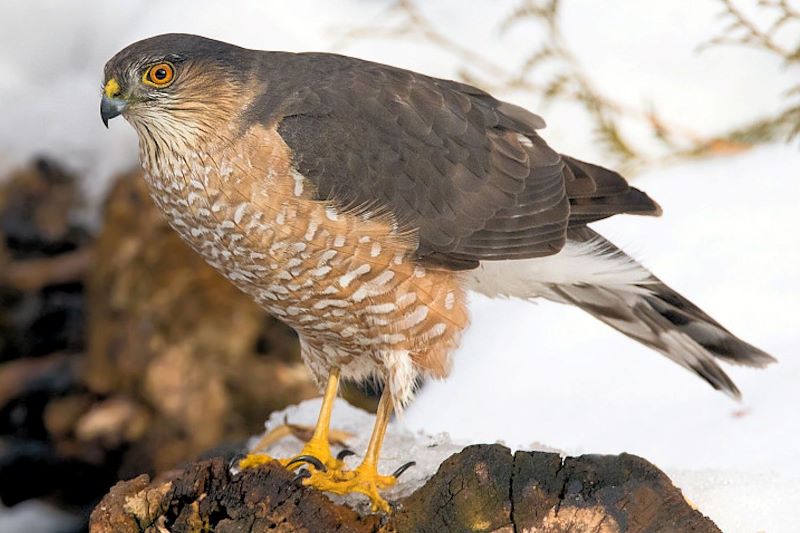
2. Sharp-Shinned Hawk (Scientific name: Accipiter striatus)
These hawks’ species are the smallest and the most athletic ones you can find in Wisconsin. An interesting fact about the Sharp-Shinned Hawks is that the females tend to be about one-third larger than the male ones.
When these hawks are flying, their wings tend to appear relatively short and rounded, but the tail appears longer. The male and female Sharp-Shinned Hawks are often spotted flying in a circular motion as a sign of courtship before they mate.
These birds often have brown feathers and some white underbelly feathers. The Sharp-Shinned Hawks mostly habituate in dense forests, and they make their nests on low-baring trees. These birds are easily identifiable by their shrill squeal and ‘kik-kik-kik’ sound.
You can spot these birds mostly around bird feeders or forested areas. They can be easily identified during the summer months of July and August before they migrate south in September. The best time to see a Sharp-Shinned Hawk nesting is also around July and August.
In Wisconsin, these birds are mostly spotted in the coniferous wetlands and Northern region forests.
Here are their measurements:
- Length: 9-13.5 Inches/23-37cm
- Weight: 3-8oz/82-220gm
- Wingspan: 16.5-26.5 Inches/42-68cm
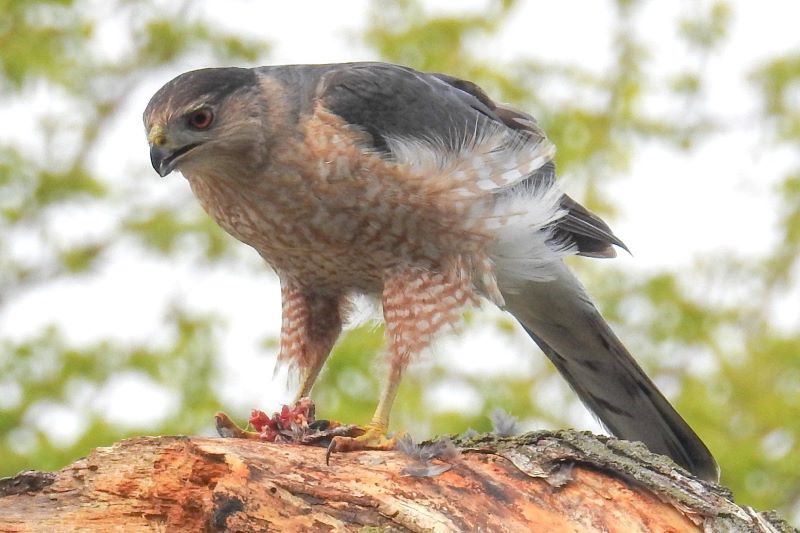
3. Cooper’s Hawk (Scientific name: Accipiter cooperii)
For this hawk species, do not rely so much on listening to the sounds they make because they’re known for being silent. The Cooper’s hawk is a medium-sized hawk, and like the Sharp-Shinned Hawks, the females tend to be bigger than the males.
In Wisconsin, you’ll mostly see these birds in the woods or at the edge of farm fields. The Cooper’s Hawks mostly have a blue-gray appearance, and they have a rufous colored chest. These birds can be differentiated from others by their alarm-like sound, ‘kuck-kuck-kuck’.
Like the Red-Tailed Hawks, you can spot the Cooper’s Hawks almost all year, but they do not breed in Wisconsin. They regularly migrate north for that. However, the best time to spot these hawks is in October during their autumn migration to the south.
Also, the best place to spot the Cooper’s Hawks might vary depending on what time you visit. If you visit during the summer, you’re likely to spot them in the northern regions, while if you’re visiting during the winter, you have better luck spotting them in the autumn regions.
Here are their measurements:
- Length: 13.5-20 Inches/ 35-50 cm
- Weight: 8-24oz/ 220-680 g
- Wingspan: 24.5-35.5 Inches/ 62-90cm

4. Northern Goshawk (Scientific name: Accipiter gentilis)
Since the Northern Goshawk is one of the birds of prey, it can be very hard to spot anywhere. They mostly habituate in large and thick forests. One thing that makes it hard to mistake the Northern Goshawk for any other hawk species is its dark head and deep red eyes.
The best way to differentiate these hawks in Wisconsin from other species is by watching them from a distance because they are very protective of their nests. Also these hawks have a sound like ‘ki-ki-ki’, which is also the alarm they use when there is an impending danger.
However, the color of the lower bodies of the Northern Goshawk might vary from one bird to another, with some downing a bluish-white while others have a light-gray color with barring. The best place to spot the Northern Goshawk in Wisconsin is in the Northern regions.
The best time to spot these birds is during the summer months when they build their nests in the northern regions of the state.
Here are their measurements:
- Length: 16-27 inches/ 41-69 cm
- Weight: 22-50oz/ 630-1400g
- Wingspan: 35-50 inches/ 89-127 cm
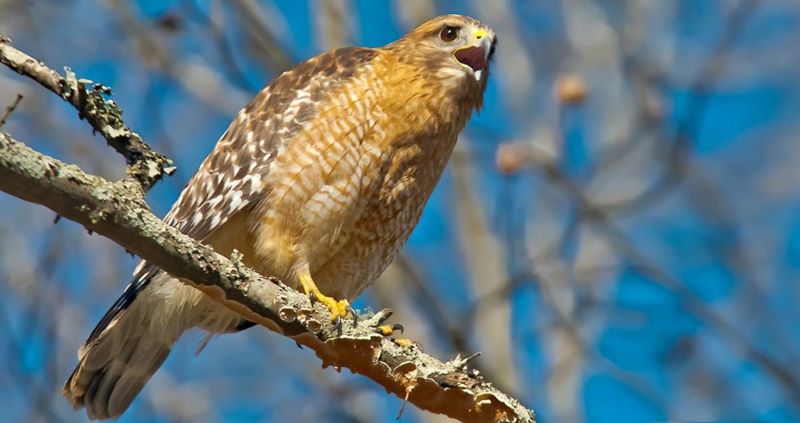
5. Red-Shouldered Hawk (Scientific name: Buteo lineatus)
These are some of the distinctly marked hawk species that you won’t mistake for any other because they happen to be one of the most colorful hawks’ species in Wisconsin. They have a barred rufous chest, and their underwings are mostly white with a strongly banded tail.
Like their name suggests, these birds have distinctive red shoulders that can be clearly visible more so when perched. The Red-Shouldered Hawks have a distinct call sound that can be described as ‘kee-aah,’ with the first note being very high and the second one very low.
It’s also very important to note that the Red-Shouldered Hawk is one of the threatened birds in the Conservation Plan. Even though these birds are evenly distributed all over Wisconsin, they can be very hard to spot.
You can mostly spot them in areas with big river systems since they mostly build their nests in trees found along riverbanks. The best time to spot these birds in Wisconsin is between March and April because this is where they choose to overwinter.
Here are their measurements:
- Length: 15-19 inches/ 38-48 cm
- Weight:1.1-1.9lbs/500-860g
- Wingspan: 38-42 inches/ 96-107cm
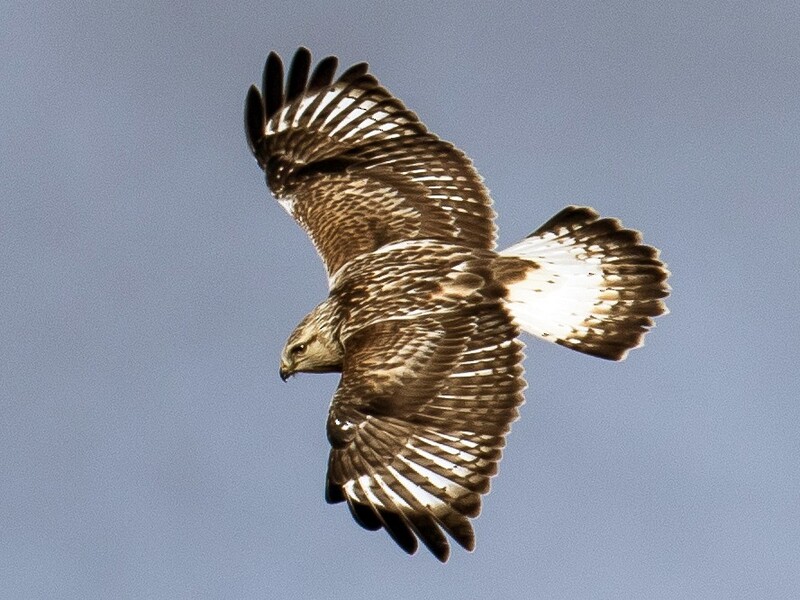
6. Rough-Legged Hawk (Scientific name: Buteo lagopus)
Also known as the Rough-Legged Buzzards or the Rough-Legged Falcons, they are very rare in Wisconsin since they spend most of their summers in Arctic tundra. These birds are mostly spotted in Wisconsin during the winter months of September and October when they migrate south.
The Rough-Legged Hawks often have pale heads, dark bellies, and dark feathers around their tip. These birds are well known to take great interest in building their nests. This is because they use bulky sticks and sometimes bones to create their nests.
Due to their secretive nature, you can only spot these birds during the early mornings as they stay hidden most of the nights.
During their migration routines, it’s not unusual to spot the Rough-Legged Hawks in open farm fields or along the United States airports. The best place to spot the Rough-Legged Hawks in Wisconsin is in Waushara County.
Their measurements are:
- Length: 18.5-23.5 inches/ 46-59cm
- Weight: 25-49oz/715-1400g
- Wingspan: 52-54 inches/ 132-138 cm
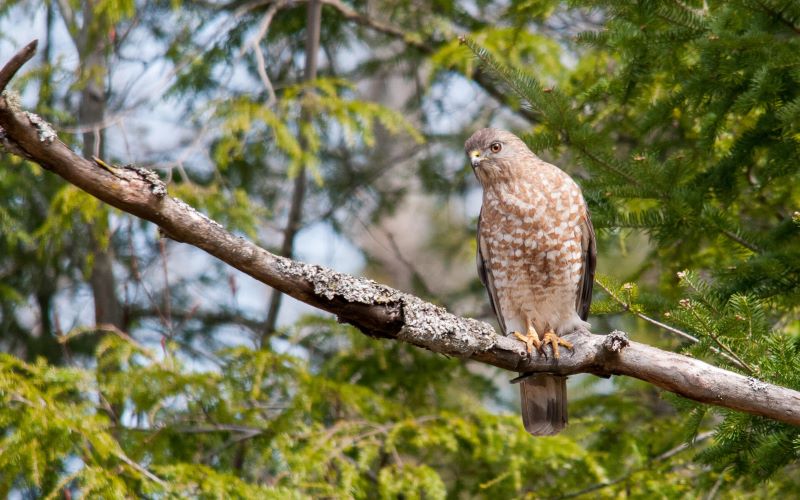
7. Broad-Winged Hawk (Scientific name: Buteo platypterus)
These birds are usually short and stocky, which makes them adaptive for life in the forest. Although the Broad-Winged Hawks are evenly distributed all around Wisconsin, they’re not commonly seen.
This is because they spend most of their time in the deep woods far ways from humans. The Broad-Winged Hawks in Wisconsin are popular among tourists due to their epic migrations each fall. Unlike other hawk species which migrate solitarily, the Broad-Winged Hawks fly in flocks.
The interesting part about their migration is that they can travel over 4000 miles in total in just one way of their migration routine, and they often complete these trips twice a year.
You can mostly spot the Broad-Winged Hawks in the Northern parts of Wisconsin, and they tend to create their nests in the forests and woodland edges. Even though these hawks have been spotted in the southern parts of Wisconsin, it’s usually in the denser forests.
These birds can mostly be spotted in Wisconsin during the summer, but they never reside in the state during winters.
Their measurements are:
- Length: 13.5-17.5 inches/ 34-44 cm
- Weight: 16oz/450g
- Wingspan: 33inches/84 cm
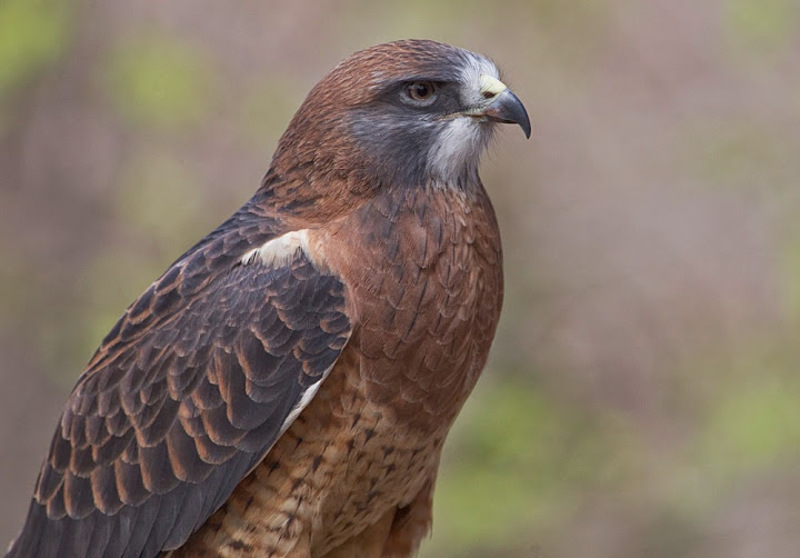
8. Swainson’s Hawk (Scientific name: Buteo swainsoni)
These hawk species are popular for having short tails and very long wings. Most of the Swainson’s Hawks have dark feathered wings, and their bellies are mostly covered in white feathers.
However, it’s important to note that these birds can have different color variations depending on the region they habituate. During the summer, the Swainson’s hawks spend most of their time in the open spaces and often create their nests in grasslands.
They are also known to spend time perched in very long trees waiting for their prey. In Wisconsin, these hawks can be easily spotted during migration which happens around October.
Their measurements are:
- Length: 18-22 inches/46-55cm
- Weight: 1.1-3.7lbs/500-1670g
- Wingspan: 4 feet/121cm
Conclusion
Even though most hawks are predators, they never attack humans without being provoked. When undeterred, hawks are a joyous and peaceful sight to watch. If you’re looking to spot hawks in action, Wisconsin is one of the best states to do it in.
Related
- Interested in more birds in Wisconsin? Check out the woodpeckers of Wisconsin.
- Wisconsin is one of our favorite locations in the world for birding. Check out more of our picks for best places to live if you happen to be an avid birder in: the best places to live for birders.
Leave a Reply